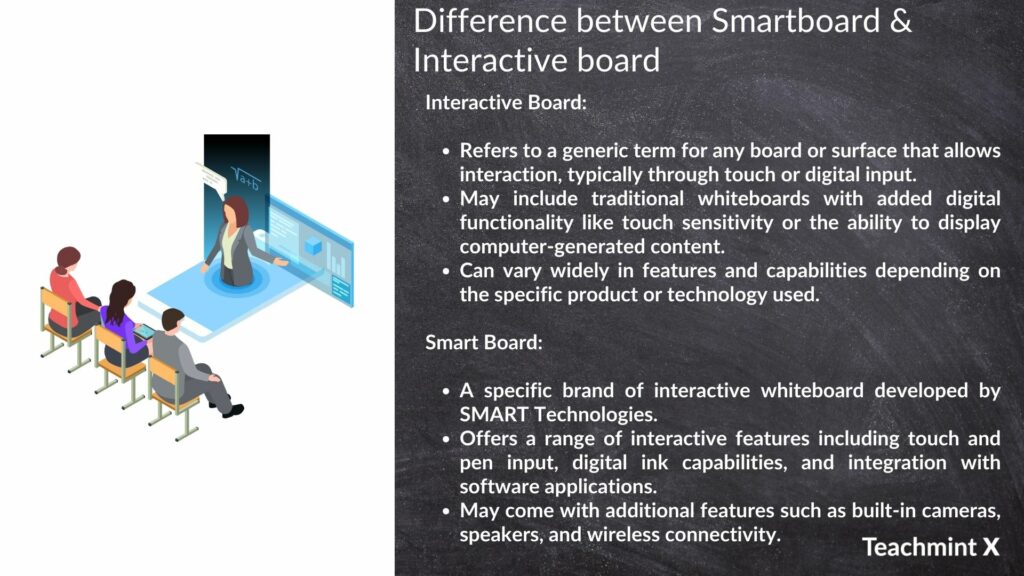Introduction:
In the ever-evolving landscape of education technology, SMART Boards and Interactive Boards have emerged as powerful tools to transform traditional classrooms into dynamic and engaging learning environments. While the terms are often used interchangeably, it is crucial to understand the subtle differences between the two.
SMART Board for Classroom:
The term “SMART Board” is often associated with interactive whiteboards developed by SMART Technologies. These boards are touch-sensitive surfaces that connect to a computer, allowing educators to control and manipulate digital content using their fingers or a stylus. SMART Boards are equipped with proprietary software that enables interactive presentations, collaborative activities, and multimedia integration. These boards have become synonymous with interactive learning experiences, fostering student participation and boosting classroom engagement.
Key Features of SMART Boards for Classroom:
- Touch-sensitive surface – This feature of SMART boards for classroom helps in navigating from one screen to another, and also to explain concepts of education much more clearly to the students.
- Integration with computer and digital content – This feature of the SMART board for classroom helps save time and efficiency in teaching methods. It allows us to use features of a computer on the large screen and access digital content from the bigger screen which helps in explaining concepts much more easily.
- Interactive software for engaging lessons – SMART board for classroom are integrated with lots of software since it is connected to the computer which makes it very interactive for the teachers to use.
- Collaborative capabilities for group activities – SMART board allows you to collaborate as well once it has access to the internet.
- Multimedia support for enhanced presentations – SMART boards allow multimedia support, which allows teachers to teach with the help of visual presentations like videos or images.

Interactive Boards for Classroom:
On the other hand, the term “Interactive Board” is a broader category that encompasses various interactive display technologies beyond SMART Boards. Interactive Boards refer to any interactive surface or display that allows users to interact with digital content. Unlike SMART Boards, Interactive Boards may be developed by different manufacturers, offering a range of features and capabilities. These boards often share the goal of creating an interactive and collaborative learning environment. In simple words interactive board doesn’t have any specific features, its features can vary according to the needs of the users.
Key Features of Interactive Boards:
- The diverse range of manufacturers and models – As mentioned above the manufacturers and models for interactive boards for classrooms may vary according to the needs, budget and availability of the features. Every model and manufacturer has their own features and advantages.
- Interactive touch or pen-based input – Interactive boards for classrooms have this prominent feature of touch-based or pen-based input systems in which you can use a special pen to draw and teach students on these boards.
- Compatibility with various devices and platforms – Interactive boards for classrooms can easily interact and support various platforms, they are very similar to mobiles but on a larger scale, this increases the uses of interactive boards.
- Customizable features based on specific educational needs – Interactive boards are easy to customize according to the needs and understanding of teachers and students. This feature helps in better Interaction between the gadgets and users.
- Enhanced collaboration tools for interactive learning – Interactive boards are very advanced and support every type of collaboration whether it is real-time collaboration, screen sharing or other types of collaboration.
Choosing the Right Solution for Your Classroom:
When considering the implementation of interactive technology in the classroom, educators must assess their specific needs and goals. SMART Boards offer a seamless and integrated solution, with a focus on user-friendly software and a touch-sensitive interface. However, Interactive Boards provide flexibility, allowing educators to choose from various models and brands based on budget constraints and technological preferences. In the end, it all depends on why are you using these boards and how can these technologies help you improve the quality of education and work.
Conclusion:
In conclusion, both SMART Boards and Interactive Boards play crucial roles in transforming traditional classrooms into dynamic, interactive, and engaging learning spaces. In the modern educational system, it is mandatory to use such technologies because of the growing competition and workload, these boards make the process much more easier and optimized. Educators must carefully evaluate the specific features, compatibility, and budget considerations when choosing the right interactive solution for their classrooms. Ultimately, the goal is to enhance the learning experience, foster collaboration, and prepare students for the digital age.
Kindly explore the Website for more information.
